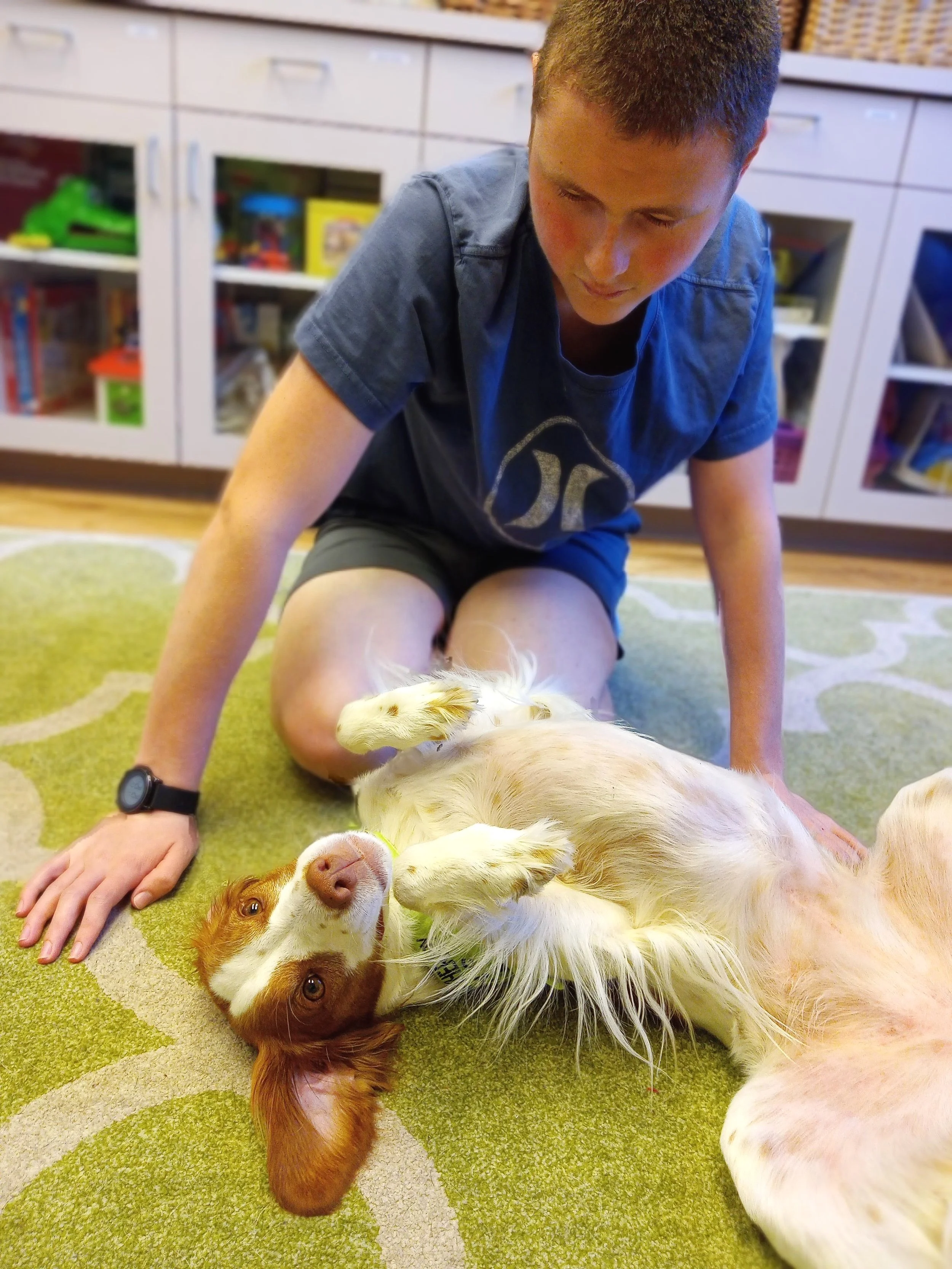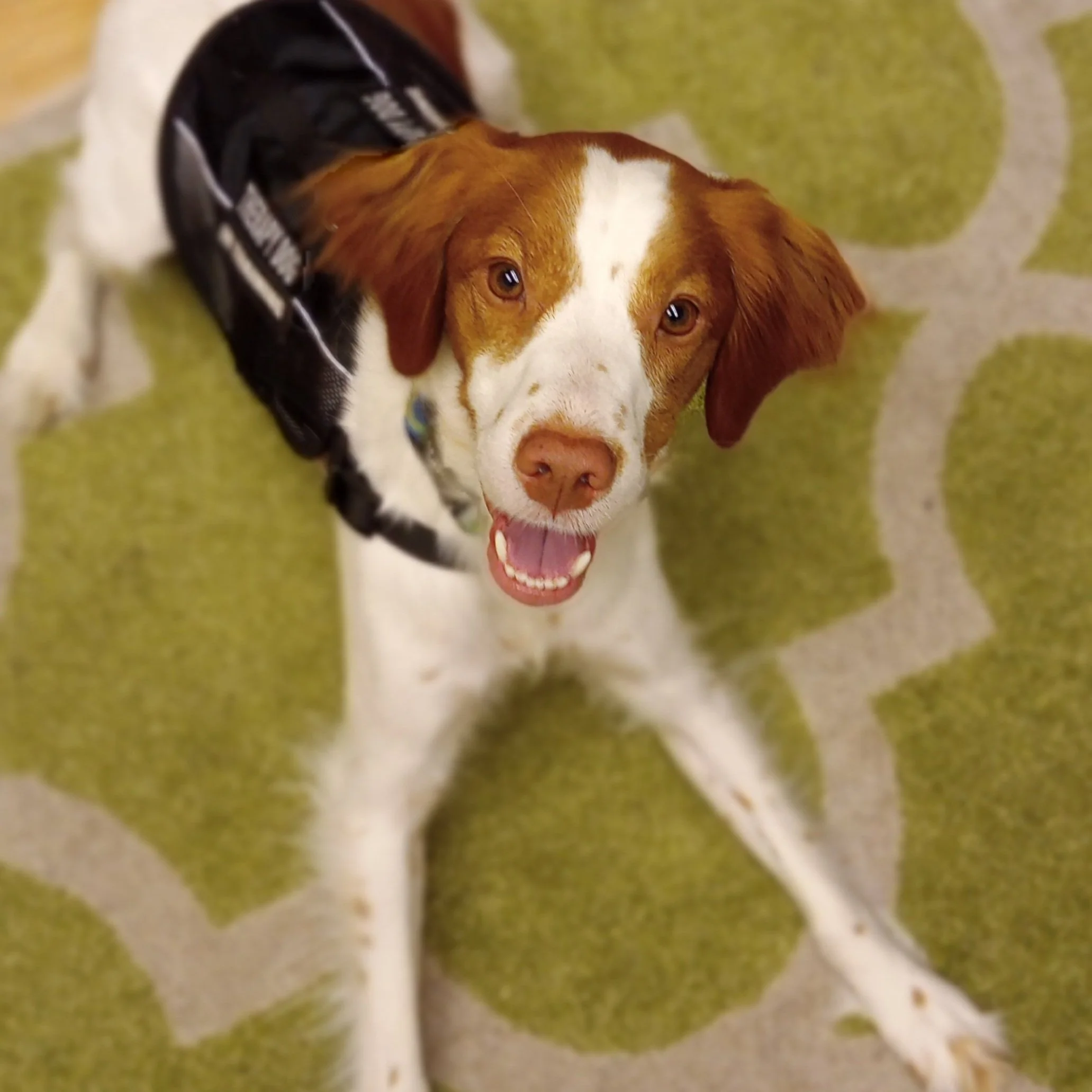Six Months of Sky: The Successes and Challenges of Partnering with a New Speech Therapy Dog
“Blue Sky” the boy called, repeating a gestalt phrase he had learned in another context. “Blue Sky, can I have a kiss?”
This being their first meeting, Sky was still a bit hesitant around this tall fifteen year old who moved jerkily and had periodic vocal tics.
I was giving her time and watching closely to see if she would actively consent to interacting with him, as she hadn’t yet experienced meeting anyone like him.
As I supported her with quiet praise and a hand on her side while making sure the boy didn’t try to hold onto her legs, Sky slowly transferred her front feet from my lap to the boy’s and began to wiggle and kiss his face.
A mutually loving bond between these two blossomed before my eyes.
This moment, about a month into Sky’s therapy dog career, is seared onto my heart. It is when I knew she was indeed meant for this work.
A natural people-lover, she nonetheless has an active and high-strung temperament, so I’ve introduced Sky into work days extra slowly to ensure she feels safe.
Sky is my mom’s dog. While I live next door and have interacted with her daily since driving home from the breeder holding her tiny fluffy body on my lap, her training and socialization nonetheless took more intentionality on my part than with my previous speech therapy dogs.
Six months into providing animal-assisted therapy together, with Sky coming one day a week and experienced speech therapy dog Delta accompanying me another two days, I’ve been pleased at what she has learned while still facing some challenges from her relative inexperience.
Here’s three challenges and three successes Sky and I have faced together over the past half a year of animal-assisted speech therapy:
Therapy dog Sky with a new best friend. Introducing Sky brought some challenges, but she’s made quick progress while providing animal-assisted speech therapy. Click here to watch her demonstrate active consent while meeting this boy for the first time.
If you click a link it is likely an affiliate link and I will earn a small commission if you purchase. It does not cost you anything extra. If I don’t use and love a product, you won’t find it here!
Therapy Dog Challenge #1: Efficient bathroom breaks between sessions
Sky is obsessed with looking for birds. Not just birds in the bushes or on the lawn, but birds flying overhead and even the shadows of planes from the small-craft airport just blocks from our office.
While she can go all day without an outdoor break if she’s resting at home alone, at work she tends to need a break about every two hours.
When I started bringing her to work in late winter, birds weren’t out and Sky would urinate at the far edges of our office parking lot after just a few minutes of sniffing around.
When spring hit, however, she was horribly distracted by the plethora of winged distractions and one day went over six hours without eliminating. With a full schedule of clients for the day I couldn’t spend long outdoors waiting for her to realize her bladder was full.
In the car afterwards she was clearly miserable. When we arrived at our after-work walk area she made it only three steps before she could hold it no longer.
Since then Sky has been more reliable in taking advantage of our walk breaks between sessions. Apparently she learned the lesson the hard way, but it still often takes longer than I would like as she first searches for birds.
To compensate, I prioritize fitting in as long of a break as possible. I just recognize that on Sky’s work days I may need to stay after a little longer to finish up data sheets and return calls that I would normally complete between clients.
Therapy Dog Success #1: Judging how much space to give a client
Sky learned fairly quickly that she could independently go to her bed or seek out a child’s caregiver for attention instead if a child was having a moment and needing some space.
While at first her instinct was to cling to me if something unexpected happened, her confidence grew within just a few full days of work and now I rarely have to direct her actions when her assistance is unneeded or a child is acting impulsively.
Therapy Dog Challenge #2: Moderating kisses
“Blue Sky” provides a much-appreciated kiss during an animal-assisted speech therapy session.
Sky simply loves people. Her naturally affiliative nature is why she bonds readily with clients and the reason I wanted to work with her in animal-assisted therapy.
However, as a smaller and more energetic dog she still struggles with impulse control, especially as families first enter the office.
While many appreciate and even ask for her enthusiastic greetings, she still needs guidance from me through commands and/or physical touch to know when enough is enough.
This is especially challenging with children, like the boy in the opening, who are happy to let her lick their face endlessly. Because of this, she is “rewarded” with their joy when she kisses uncontrollably.
We are working on establishing a “one kiss and done” routine when kids lean toward her for a kiss, and she is needing less intervention on my part for this. However, I suspect it will always be something I have to manage as we find the balance of allowing that human-animal bond to develop while minimizing the sharing of saliva.
(For more, see also The Perfectly Imperfect Therapy Dog: Knowing When to Train and When to Manage.)
Therapy Dog Success #2: Energy conservation across a long day of animal-assisted therapy
I was needlessly worried that Sky would become overly tired as I increased her hours at the office.
My retired speech therapy dog Johnny Utah, the same breed and energy-level as Sky, had struggled for nearly a year with separating from kids to take naps on his bed whenever they were engaged with other activities. Sky, however, very quickly learned this skill.
I have included sunflower butter stuffed Kongs and chew toys from the start to give her a reason to stay on her bed and decompress, so either that helped or she is just more naturally aware of her own needs than Johnny was.
(For an in-depth discussion of using Kongs and other materials for decompression, check out this Therapy Dogs Australia podcast. )
Speech therapy dog Sky takes advantage of a quiet moment to rest between activities where her help is more needed during animal-assisted therapy.
Therapy Dog Challenge #3: Learning a skill-set of tricks for animal-assisted therapy
Though Sky had very quickly learned basic obedience like sit, down, and stay as we worked through our Canine Good Citizen classwork, I knew a few fun tricks would help engage my clients as well.
(See Sky Did It: Four Ways Training for the CGC Benefited our Speech Therapy Dog Journey)
I could lure her into just about anything (except roll-over), but she didn’t seem to be making the connection to a verbal and/or hand cue. However, because we had passed the CGC and she was coming to work consistently, I had stopped working with her consistently at home and was primarily relying on down times at work to sneak in a few minutes of training.
Oops! I [finally] realized this was not the context in which to try to teach new skills, as she was already learning all the little skills that go into being a speech therapy dog.
This realization hit me so hard I actually wrote an entire post, Learning the Hard Way: Reducing Overwhelm in Your Speech Therapy Dog (and You!
Though she struggled a bit at first to learn tricks, therapy dog Sky now both shakes and gives high-fives with enthusiasm during animal-assisted speech therapy. Ultimately, the bond she’s developed with clients and their caregivers is her most important therapy dog quality, though.
Therapy Dog Success #3: Bonding with families
Sky is darling.
There’s just no arguing that. And while a few families have mentioned preferring Delta’s calmer demeanor, most have welcomed Sky and all her antics with enthusiasm!
Sky seems to love them right back. In fact, within a couple months of starting routine therapy dog work I noticed she started sitting in the waiting room between clients, looking at the door to see who was coming next just like Delta often does.
As a bonus, because she is so enamored with greeting everyone that arrives she has proven herself trustworthy when the office door is opening. I still watch closely, but my worries about her getting into the hall and taking off have been unfounded because she is so busy sniffing and wiggling around the legs of entering friends.
(Just to be safe though, I do routinely practice “come” in the hallway with a big reinforcer.)
How cute is new speech therapy dog Sky? Her enthusiasm has been overwhelmingly welcomed by my animal-assisted speech therapy clients and their families.
As you partner with a therapy dog, I hope Sky’s story will help you stay patient and optimistic through your journey.
Adjusting to a professional role is extremely demanding for a therapy dog, with long days of meeting people with a wide variety of interaction styles and needs. Just as we started our career guided by mentors and feeling overwhelmed by all the skills we need to know to help clients, it takes time for a therapy dog to blossom into a powerful co-therapist.
For now, I’m excited to see where our next six months, and hopefully six plus years, will take us!
If you’d like to learn more about partnering with speech therapy dogs, Paws for Progress: Integrating Animal-Assisted Interventions Into Your Speech-Language Pathology Practice is now available from ASHA Press and Amazon!
And check out the new online course, Talk to the Paw: Foundations for Therapy Animal Inclusion in a Professional Setting. Over 7 hours of content with more than 70 vide clips from actual animal-assisted therapy sessions to illustrate the the what, why, and how of therapy animal partnership!
May your days be filled with puppy wiggles and children’s giggles,
Sharlet






